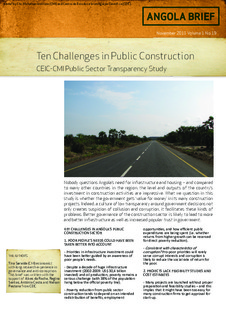| dc.contributor.author | Søreide, Tina | |
| dc.contributor.author | da Rocha, Alves | |
| dc.contributor.author | Santos, Regina | |
| dc.contributor.author | Costa, António | |
| dc.contributor.author | Pestana, Nelson | |
| dc.date.accessioned | 2018-01-04T08:17:17Z | |
| dc.date.available | 2018-01-04T08:17:17Z | |
| dc.date.issued | 2011-11-30 | |
| dc.identifier | oai:www.cmi.no:4288 | |
| dc.identifier.citation | Bergen: Chr. Michelsen Institute (Angola Brief vol. 1 no. 19) 4 p. | |
| dc.identifier.issn | 1892-3933 | |
| dc.identifier.uri | http://hdl.handle.net/11250/2474729 | |
| dc.description.abstract | Nobody questions Angola’s need for infrastructure and housing – and compared to many other countries in the region, the level and outputs of the country’s investment in construction activities are impressive. What we question in this study is whether the government gets ‘value for money’ in its many construction projects. Indeed, a culture of low transparency around government decisions not only creates suspicion of collusion and corruption, it facilitates these kinds of problems. Better governance of the construction sector is likely to lead to more and better infrastructure as well as increased popular trust in government. | |
| dc.language.iso | eng | |
| dc.publisher | Chr. Michelsen Institute | |
| dc.relation | Angola Brief | |
| dc.relation | 19 | |
| dc.relation.ispartof | Angola Brief | |
| dc.relation.ispartofseries | Angola Brief vol. 1 no. 19 | |
| dc.relation.uri | https://www.cmi.no/publications/4288-ten-challenges-in-public-construction | |
| dc.subject | Angola | |
| dc.title | Ten challenges in public construction. CEIC-CMI public sector transparency study | |
| dc.type | Report | |
